Gardens of the Anthropocene
Augmented Reality Installation in public space by Tamiko Thiel, 2016 - 2017Originally commissioned for the Seattle Art Museum Olympic Sculpture Park in summer 2016
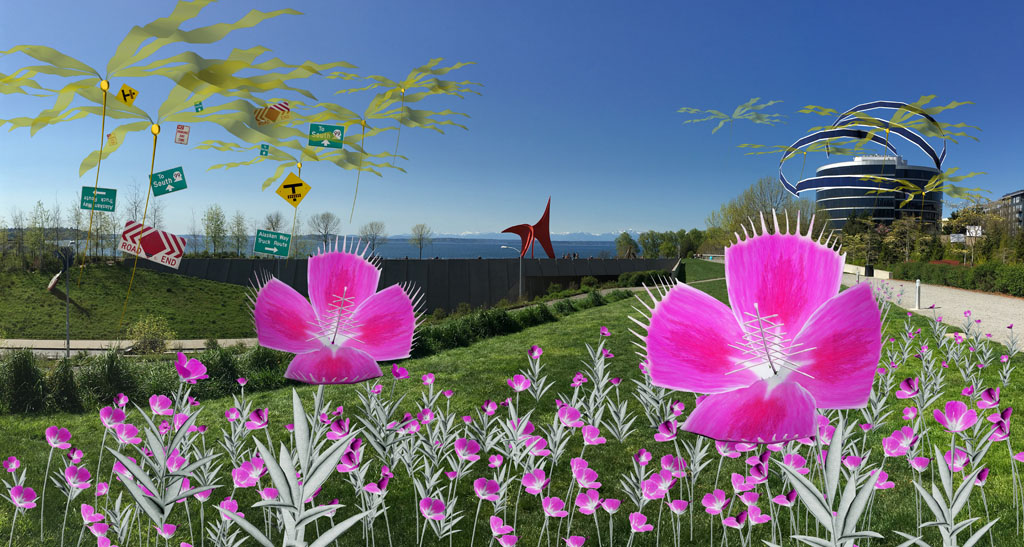
Gardens of the Anthropocene, AR installation, Tamiko Thiel, 2016.
Seattle Art Museum Olympic Sculpture Park commission.
View VIDEO @ Olympic Sculpture Park >>>
Seattle Art Museum Olympic Sculpture Park commission.
View VIDEO @ Olympic Sculpture Park >>>
The augmented reality (AR) installation Gardens of the Anthropocene posits a science fiction future in which native aquatic and terrestrial plants have mutated to cope with the increasing unpredictable and erratic climate swings. The plants in the installation are all derived from actual native plants in and around the Olympic Sculpture Park that are tolerent respectively to drought on land or to warming sea waters, and are therefore expected to adapt to the increasing temperatures to come.
Beyond this actual scientific basis, however, the artwork takes artistic license to imagine a surreal, dystopian scenario in which plants are "mutating" to breach natural boundaries: from photosynthesis of visible light to feeding off of mobile devices' electromagnetic radiation, from extracting nutrients from soil to feeding off man-made structures, and to transgressing boundaries between underwater and dry land, between reactive flora and active fauna.

"Gardens of the Anthropocene, AR installation, Tamiko Thiel, 2016. Artist visualization at Stanford University.
The plants in Gardens of the Anthropocene are species that will be able to resist the changing climate in Seattle, which in time will become more like that of Northern California. In fact, a second cluster was discovered on the Stanford University campus, between Memorial Auditoriam and the Hoover Tower, as seen in the screenshot above.
The plants
Bullwhip kelp drones Nereocystis volans
(Presumed mutation of Nereocystis luetkeana)
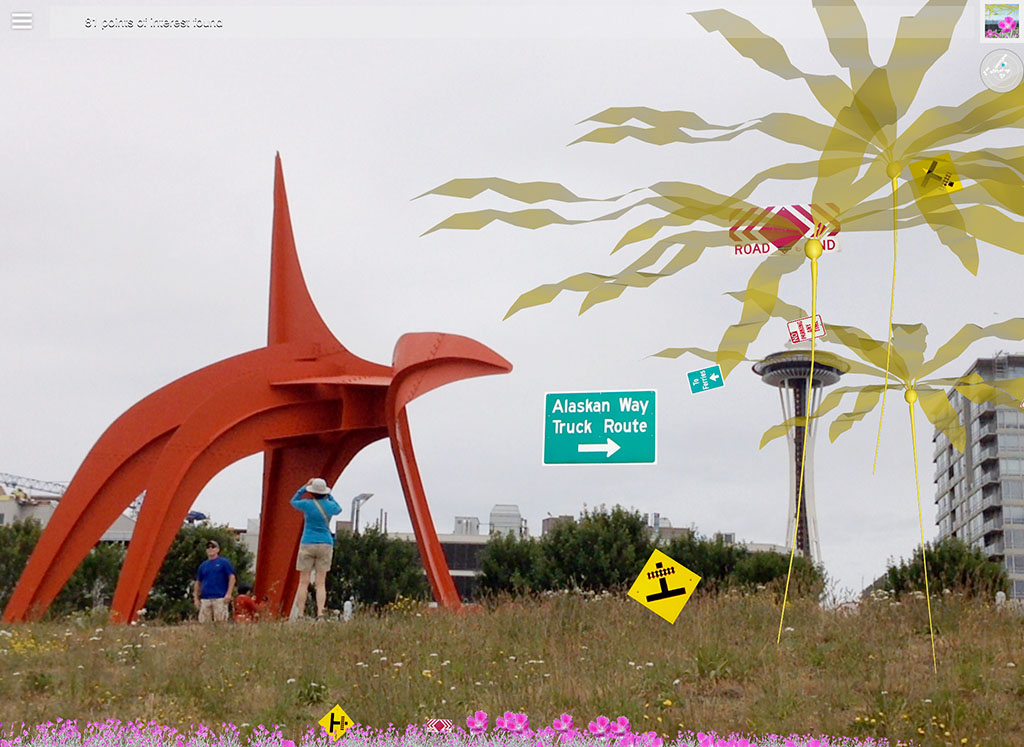
Bullwhip kelp drones (Nereocystis volans) feeding off street signs from the last storm surge. Gardens of the Anthropocene, AR installation, Tamiko Thiel, 2016, in the Seattle Art Museum Olympic Sculpture Park.
The original Bullwhip Kelp Nereocystis luetkeana were used by Northwest Coast Indians for everything from food to storage containers, fishing lines and ropes. Growing up to 120 feet long, they live in deeper offshore waters. In Gardens of the Anthropocene they have mutated to Nereocystis volans, amphibious flying "drones" that can range freely up the slopes of the Olympic Sculpture Park. In the aftermath of storm surges that tear away roadside fixtures and destroy buildings they feed off of man-made structures and detritus, carrying them off in the vortex of their rotor blades.
Information on the presumptive ancestor species Nereocystis luetkeana:
- https://themarinedetective.com/category/algaeseaweed/
- http://www.primitiveways.com/bull_whip_kelp.html
Antennate Farewell to Spring: Clarkia antenna
Alternate name: Clarkia irritabilia (Presumed mutation of "Farewell to Spring" Clarkia amoena)
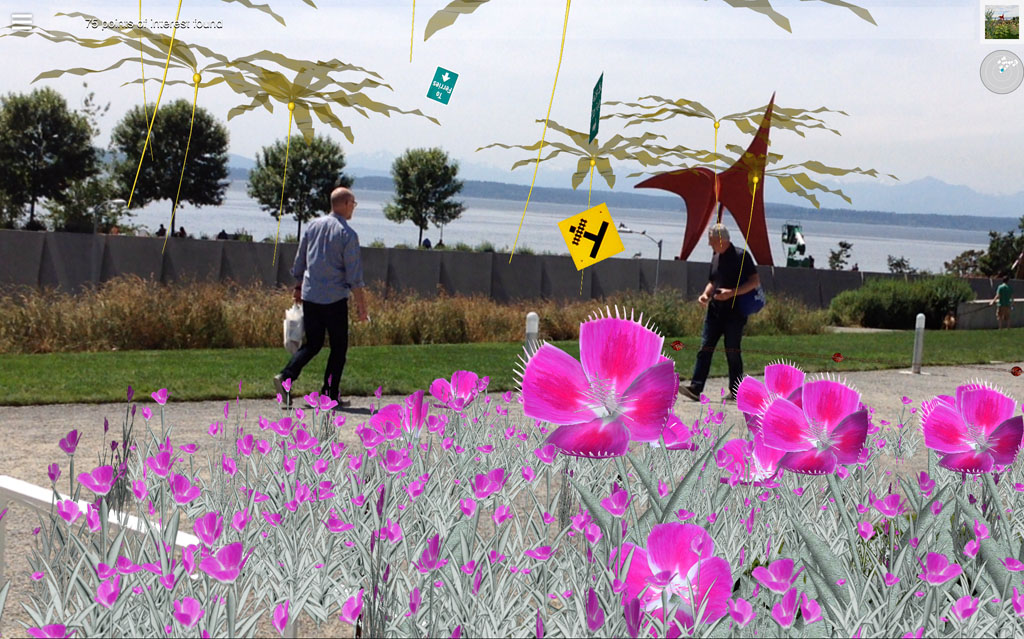
Antennate Farewell to Spring in foreground; bullwhip kelp drones and Calder's "Eagle" in the background. Gardens of the Anthropocene, AR installation, Tamiko Thiel, 2016, in the Seattle Art Museum Olympic Sculpture Park.

Antennate Farewell to Spring and Bullwhip Kelp Drones. Gardens of the Anthropocene, AR installation, Tamiko Thiel, 2016, in the Seattle Art Museum Olympic Sculpture Park. (Click on image to watch the video)
In Gardens of the Anthropocene farewell-to-spring plants have mutated to develop succulent drought-resistant leaves, and as the species names Clarkia irritabilis or Clarkia antenna imply, have also become preternaturally reactive. In the OSP we see two or three stages of development, in which the stamens and pistils begin to fuse into an antenna-like form. In the final mutation, the flower petals have developed "marginal teeth" on their rims that detect the presence of mobile devices, and the flowers enlarge to apparently feed off the electromagnetic emissions. The behavior of the flowers is unnerving, but does not produce any known ill effects in humans.
Information on the presumptive ancestor species Clarkia amoena:
- http://mother-natures-backyard.blogspot.com/2015/06/plant-of-month-june-farewell-to-spring.html
- http://davesgarden.com/guides/pf/showimage/33296/
Radar Camas: Camassia radaria
Alternate name: Clarkia irritabilia (Presumed mutation of "Farewell to Spring" Clarkia amoena)
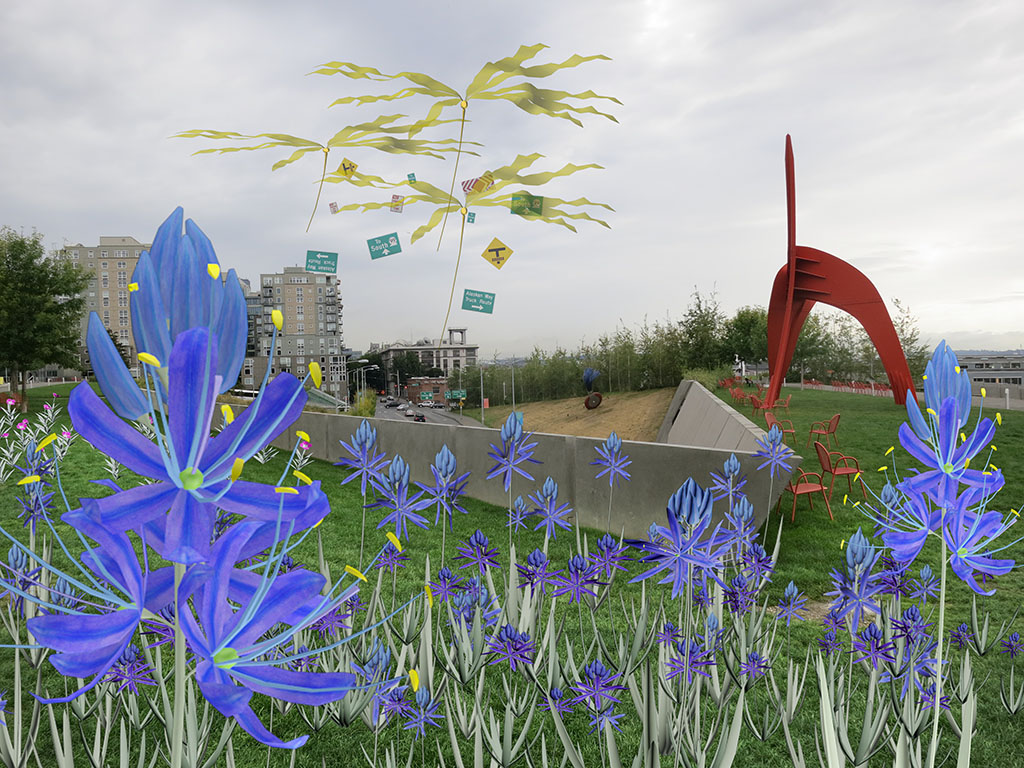
Radar Camas (foreground), bullwhip kelp drones and Calder's "Eagle" in the background. Gardens of the Anthropocene, AR installation, Tamiko Thiel, 2016, in the Seattle Art Museum Olympic Sculpture Park.
Harvesting the blue camas, once a major source of food for Native Americans, always required careful attention to its flowers due to the similarity of its leaves to those of the poisonous "death camas." In Gardens of the Anthropocene a new, presumed mutant variety of the blue camas, Camassia radaria, has emerged. The leaves have become fleshy grey-green as in a succulent plant, in order to resist dessication as rainfall becomes more rare. The flowers of the Radar Camas can be differentiated from the visually similar blue camas by their motile behavior: when approached the flowers become agitated and begin to rotate like a radar antenna. Care should be used in injesting the plant, as it may have become toxic as well.
Information on the presumptive ancestor species blue camas Camassia quamash:
- "'Nearly all the men sick:' Lewis and Clark Meet the Camas Root," Francis Hunter.
- " Camassia quamash, Blue Camas," Joe Arnett.
Alexandrium giganteus / Alexandrium aerius
(Presumed mutation of dinoflagellate Alexandrium catenella)
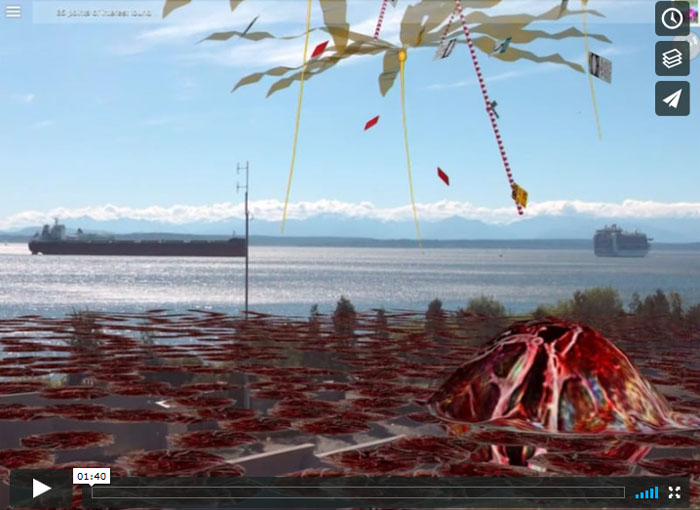
VIDEO of Alexandrium Giganteus at Seattle Art Museum Olympic Sculpture Park in 2016, since eradicated. Gardens of the Anthropocene, AR installation, Tamiko Thiel, 2016.
The microscopic algae Alexandrium catenella causes toxic "red tides" (harmfull algal bloom) in Puget Sound and will thrive in warming waters. In Gardens of the Anthropocene it has produced a strangely gigantic and mobile mutation. No longer a single-celled microscopic algae, the mutated species has transformed into what could be termed Alexandrium giganteus because of its size, or Alexandrium aerius because it has become airborne and can float over land. A parent pod seems to be able to emit large numbers of smaller child spores, which are initially flat but will presumeably gain a characteristic spherical shape when mature.
As the presumptive ancestor species Alexandrium catenella is highly toxic, it can be presumed that Alexandrium giganteus is toxic as well and should not be injested.
Information on the presumptive ancestor species Alexandrium catenella:
- Alexandrium catenella." National Oceanic and Atmospheric Administration's Northwest Fisheries Science Center.
- " The globally distributed genus Alexandrium: multifaceted roles in marine ecosystems and impacts on human health." US National Library of Medicine National Institutes of Health.
- "Marine Biotoxin Bulletin." Washington State Department of Health, Environmental Public Health Programs, Office of Shellfish and Water Protection.